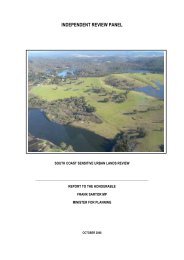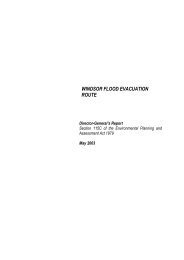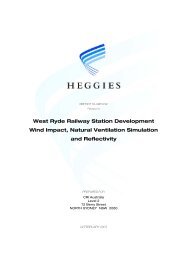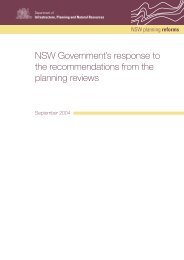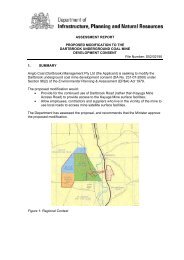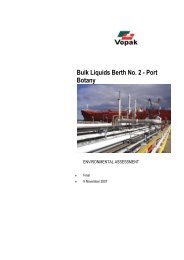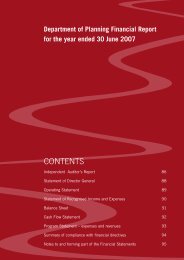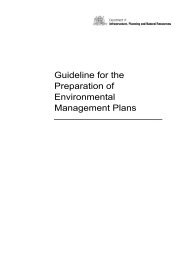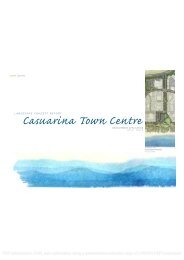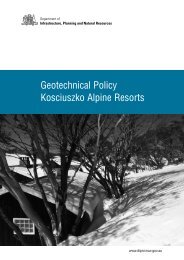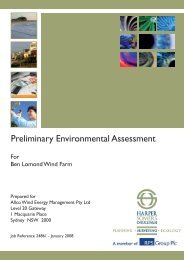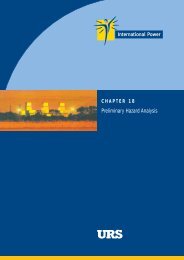Appendix P Drainage, Flooding, Stormwater Management Part 5
Appendix P Drainage, Flooding, Stormwater Management Part 5
Appendix P Drainage, Flooding, Stormwater Management Part 5
You also want an ePaper? Increase the reach of your titles
YUMPU automatically turns print PDFs into web optimized ePapers that Google loves.
<strong>Flooding</strong>, <strong>Drainage</strong> and <strong>Stormwater</strong> <strong>Management</strong><br />
Sanctuary Villages<br />
A comparison of PRM and XP-RAFTS flow rate estimates at Millfield Bridge for the 1, 5,<br />
10, 20, 50 and 100 year ARI storm events is provided in Table 3-1. The critical storm<br />
duration that produced the peak discharge for the 1 year ARI event was the 720 minute<br />
storm. For all other storm events, the 2160 minute storm duration produced the largest<br />
peak discharge.<br />
Note that these flow estimates do not account for temporary storage provided by Ellalong<br />
Lagoon.<br />
Table 3-1:<br />
Comparison of PRM and XP-RAFTS Peak Discharges<br />
ARI PRM Estimate (m 3 /s) XP-RAFTS Estimate<br />
(m 3 /s)<br />
Percentage Difference<br />
1 Year 114 81 -29%<br />
5 Year 267 289 +8%<br />
10 Year 344 388 +13%<br />
20 Year 444 525 +18%<br />
50 Year 589 663 +13%<br />
100 Year 729 809 +11%<br />
The following features of the PRM could explain the minor discrepancies with modelpredicted<br />
results:<br />
<br />
<br />
<br />
<br />
<br />
Only a peak flow estimate is provided and the hydrograph shape is not considered.<br />
A constant rainfall intensity is adopted with the temporal variability of rainfall not<br />
accounted for.<br />
The estimation of time of concentration and runoff coefficient is subjective.<br />
The PRM does not explicitly allow for catchment surface storage and routing, which<br />
may tend to produce high flow estimates in steep catchments.<br />
From Table 3-1, XP-RAFTS model predicts higher discharges than the PRM for all<br />
ARI events except the 1 year. The magnitudes of the differences, however, are<br />
considered within limits of engineering best practice for flow estimation.<br />
3.1.5 Existing peak discharges<br />
Existing peak discharges allow for storage provided by Ellalong Lagoon. The heightstorage<br />
and height-discharge relationship for Ellalong Lagoon is shown in Figure 4. The<br />
height-storage relationship was interpolated from the Quorrobolong 1:25,000 topographic<br />
map, which has a 10m contour interval. The height-discharge relationship is based on<br />
culvert hydraulics for inlet control and allows for Congewai Road to function as a weir<br />
during high flows. Also provided on Figure 4, for comparative purposes, is the<br />
documented PBP height-storage-discharge relationship for Ellalong Lagoon.<br />
The existing culverts have been estimated as having an invert level at 110.5m AHD with<br />
the minimum elevation along Congewai Road being 113.2m AHD. It is estimated that<br />
Congewai Road is depressed for a length of approximately 500m.<br />
PARSONS BRINCKERHOFF 2122870A-PR0116 Page 10
<strong>Flooding</strong>, <strong>Drainage</strong> and <strong>Stormwater</strong> <strong>Management</strong><br />
Sanctuary Villages<br />
A summary of existing peak discharges at Millfield Bridge (node CON.15) for the 1, 5, 10,<br />
20, 50 and 100 year ARI storm events is provided in Table 3-2. Also provided are peak<br />
discharge estimates documented in the Patterson Britton and <strong>Part</strong>ners (PBP) flood study<br />
(April 2004) at the same location. The critical storm duration that produced the peak<br />
discharge for all events except the 1 year ARI event was the 2160 minute storm. The<br />
peak discharge for the 1 year ARI event occurred for the 720 minute storm.<br />
Estimated hydrographs at Millfield Bridge (node CON.15) for the 1, 5, 10, 20, 50 and 100<br />
year ARI critical duration storm event are provided in <strong>Appendix</strong> D.<br />
800<br />
4,000<br />
700<br />
3,500<br />
600<br />
3,000<br />
Discharge (m 3 /s)<br />
500<br />
400<br />
300<br />
2,500<br />
2,000<br />
1,500<br />
Storage (ML)<br />
200<br />
1,000<br />
100<br />
500<br />
0<br />
0<br />
110.5 111 111.5 112 112.5 113 113.5 114<br />
Height (m AHD)<br />
PB H-Q Relationship PBP H-Q Relationship PB H-S Relationship PBP H-S Relationship<br />
Figure 4:<br />
Height-Storage-Discharge Relationship for Ellalong Lagoon<br />
Table 3-2:<br />
Existing peak discharges at Millfield Bridge (Node CON.15)<br />
ARI<br />
Existing Peak<br />
Discharge (m 3 /s)<br />
Critical Storm<br />
Duration (min)<br />
PBP Peak Discharge<br />
Estimate (m 3 /s)^<br />
1 Year 62 720 -<br />
5 Year 221 2160 255<br />
10 Year 296 2160 -<br />
20 Year 392 2160 434<br />
50 Year 571 2160 -<br />
100 Year 762 2160 654<br />
^ PBP peak discharge estimate has been provided for comparative purposes only.<br />
PARSONS BRINCKERHOFF 2122870A-PR0116 Page 11
<strong>Flooding</strong>, <strong>Drainage</strong> and <strong>Stormwater</strong> <strong>Management</strong><br />
Sanctuary Villages<br />
Existing peak discharges at Millfield Bridge for the 5 and 20 year ARI storm events are<br />
generally in close agreement with estimates documented in the Wollombi Valley Flood<br />
Study prepared by Patterson Britton and <strong>Part</strong>ners (April 2004). The predicted 100 year<br />
discharge is 17% larger than that documented by PBP. This may be due to variations in<br />
the height-storage-discharge relationship adopted by both Consultants.<br />
A summary of existing peak discharges, peak storage and peak water level at Ellalong<br />
Lagoon (node QUO.7) for the 1, 5, 10, 20, 50 and 100 year ARI storm event is provided<br />
in Table 3-3, and will be used as a baseline comparison for evaluating the impacts of the<br />
development on existing flow rates, as well as for estimating the 100 year ARI flood levels<br />
within the study area.<br />
Table 3-3:<br />
ARI<br />
Existing peak discharge, peak storage and peak water level in Ellalong Lagoon<br />
Existing Peak<br />
Discharge (m 3 /s)<br />
Critical Storm<br />
Duration (min)<br />
Peak Storage<br />
(ML)<br />
Peak Water Level<br />
(m AHD)<br />
1 Year 16 720 473 111.23<br />
5 Year 64 2160 1,560 112.35<br />
10 Year 80 2160 1,560 112.84<br />
20 Year 141 2160 2,820 113.34<br />
50 Year 231 2160 3,030 113.51<br />
100 Year 305 2160 3,160 113.62<br />
3.2 Developed hydrology<br />
3.2.1 Potential hydrological impacts of development<br />
Urban development typically results in an increase in the impervious surfaces within a<br />
catchment and engineering works to collect and convey runoff. Without appropriate<br />
management, several potential impacts result from development. These could include:<br />
<br />
<br />
<br />
increased frequency of runoff events;<br />
increased runoff volume, peak flow and velocity; and<br />
decreased groundwater base flows and lowering of the watertable.<br />
These impacts may in turn lead to:<br />
<br />
<br />
<br />
<br />
inundation of downstream property and infrastructure;<br />
change in existing channel form and sediment transport;<br />
damage to riparian and aquatic vegetation; and<br />
damage to existing aquatic ecosystems and natural wetlands.<br />
3.2.2 Model parameters<br />
The effect of urbanisation, of the proposed development site, was modelled using XP-<br />
RAFTS and involved the inclusion of impervious areas within the existing model. The<br />
model was then used to estimate developed peak flow rates at Millfield Bridge (node<br />
CON.15).<br />
PARSONS BRINCKERHOFF 2122870A-PR0116 Page 12
<strong>Flooding</strong>, <strong>Drainage</strong> and <strong>Stormwater</strong> <strong>Management</strong><br />
Sanctuary Villages<br />
Details of XP-RAFTS developed model catchment data are summarised in <strong>Appendix</strong> B.<br />
Node locations used in the XP-RAFTS developed model are identical to those for the<br />
existing model and are shown in Figure 3.<br />
The percentage of impervious area for the development site has been adopted as 60%.<br />
This value has been adopted to represent the relative contribution of various land types<br />
including; road reserves, commercial, residential and parkland. This assumption is valid<br />
for a regional level study but a more detailed breakdown of land use will be considered at<br />
the local strategy level.<br />
3.2.3 Developed peak discharges<br />
Predicted developed flow rates within Congewai Creek at Millfield Bridge for the 1, 5, 10,<br />
20, 50 and 100 year ARI storm events are summarised in Table 3-4. Also shown are<br />
existing peak flow rates at this location and the percentage change in flow resulting from<br />
development. Runoff hydrographs for the critical duration storm that produced the largest<br />
peak flow estimate are provided in <strong>Appendix</strong> E for developed conditions. The critical<br />
storm duration that produced the peak flow rate at node CON.15 was the 720 minute<br />
storm for the 1 year ARI event and 2160 minute storm for all other events.<br />
Table 3-4: Developed peak flow estimates within Congewai Creek at Millfield Bridge (Node<br />
CON.15)<br />
ARI<br />
Existing Peak Flow<br />
Rate (m 3 /s)<br />
Developed Peak<br />
Flow Rate (m 3 /s)<br />
Percentage Change<br />
1 Year 62 62 0%<br />
5 Year 221 221 0%<br />
10 Year 296 295 -0.3%<br />
20 Year 392 391 -0.2%<br />
50 Year 571 571 0%<br />
100 Year 762 761 -0.1%<br />
Table 3-4 illustrates that the proposed development results in a negligible change in the<br />
critical duration peak flow rate at Millfield Bridge for the 1, 5, 10, 20, 50 and 100 year ARI<br />
storm events.<br />
Examination of Figure 3 shows the proposed development area to be located near the<br />
outlet of the analysed catchment, which extends as far as Millfield Bridge. The<br />
introduction of impervious surfaces at this location increases the rate of runoff from the<br />
lower portions of the catchment allowing runoff to enter Congewai Creek before the<br />
overall catchment flood peak. This is further supported by examination of the developed<br />
runoff hydrograph for the 1 year critical duration storm event contained within <strong>Appendix</strong><br />
E, which shows a small spike on the rising limb of the hydrograph when compared to the<br />
existing runoff hydrograph at this location.<br />
A comparison of existing and developed peak flow rates for the 1, 10 and 100 ARI storm<br />
events run for a range of storm durations is shown in Figure 5. Examination of Figure 5<br />
reveals negligible change in peak flow rate for the 10 and 100 year ARI storm events at<br />
Millfield Bridge for all storm durations. However, there is a minor increase in peak flow<br />
rate for the shorter duration 1 year ARI storm events. This increase in flow rate will<br />
require detention storage to reduce the potential for scour of existing drainage lines.<br />
PARSONS BRINCKERHOFF 2122870A-PR0116 Page 13
<strong>Flooding</strong>, <strong>Drainage</strong> and <strong>Stormwater</strong> <strong>Management</strong><br />
Sanctuary Villages<br />
This study has considered the impact of the development on the major (regional) flood<br />
events. Future stormwater strategies should consider the impact of the development on<br />
local stormwater runoff flow rates. The results of the future stormwater management<br />
strategy are likely to indicate the need for stormwater detention at local outfalls, which<br />
should also resolve the impact of the development on shorter duration 1 year ARI<br />
regional storm events.<br />
Details of stormwater management measures that may be considered in future detailed<br />
stormwater management strategies are provided in Section 5.<br />
PARSONS BRINCKERHOFF 2122870A-PR0116 Page 14
900<br />
800<br />
700<br />
600<br />
500<br />
400<br />
300<br />
200<br />
100<br />
0<br />
<strong>Flooding</strong>, <strong>Drainage</strong> and <strong>Stormwater</strong> <strong>Management</strong><br />
Sanctuary Villages<br />
30 45 60 90 120 180 270 360 540 720 1080 1440 1800 2160 2880<br />
Storm Duration (min)<br />
1 year Existing Flow 1 year Developed Flow 10 year Existing Flow 10 year Developed Flow<br />
100 year Existing Flow 100 year Developed Flow<br />
Figure 5: Comparison of 1, 10 and 100 year ARI storm events for a range of storm durations<br />
PARSONS BRINCKERHOFF 2122870A-PR0116 Page 15<br />
Peak Flow Rate (m 3 /s)
<strong>Flooding</strong>, <strong>Drainage</strong> and <strong>Stormwater</strong> <strong>Management</strong><br />
Sanctuary Villages<br />
4. Hydraulic modelling<br />
The HEC-RAS (Version 3.1.2, April 2004) computer model, developed by the Hydrologic<br />
Engineering Centre, U.S. Army Corps of Engineers was used to determine the 100 year<br />
water profile within Congewai and Quorrobolong Creeks south of the development precincts.<br />
The programme uses the standard step method to determine water surface profiles for<br />
gradually varied flow.<br />
4.1 Modelling parameters<br />
The hydraulic analysis has been undertaken as a steady state simulation. A brief discussion<br />
on model parameters is provided below. Storage within Ellalong Lagoon has been<br />
accounted for in the hydrologic model described in Section 3.<br />
4.1.1 Flow regime<br />
A mixed flow regime analysis was undertaken for the analysed portion of Congewai and<br />
Quorrobolong Creeks situated within the study area.<br />
4.1.2 Boundary conditions<br />
For mixed flow, both upstream and downstream boundary conditions are required for model<br />
simulation. The upstream boundary conditions assumed normal flow with a creek slope of<br />
0.003. The sensitivity of the model to this slope has not been examined but is likely to be<br />
negligible given that flow is subcritical.<br />
The downstream boundary condition comprised a fixed water level that was obtained from<br />
the Wollombi Valley Flood Study prepared by Patterson Britton and <strong>Part</strong>ners. A level of<br />
110.1m AHD, which is situated approximately 150m upstream of Millfield Bridge, was<br />
adopted. The sensitivity of the model to this starting level has not been examined.<br />
4.1.3 Peak flows<br />
A summary of 100 year ARI peak flow rates used within the hydraulic model are provided in<br />
Table 4-1. These flows were taken from the XP-RAFTS model for the 2160 minute critical<br />
storm duration. Note that the existing and developed peak flow rate estimates for the critical<br />
duration storm event are identical.<br />
PARSONS BRINCKERHOFF 2122870A-PR0116 Page 16
<strong>Flooding</strong>, <strong>Drainage</strong> and <strong>Stormwater</strong> <strong>Management</strong><br />
Sanctuary Villages<br />
Table 4-1:<br />
XP-RAFTS<br />
Node<br />
100 year flows adopted in hydraulic model<br />
Creek<br />
HEC-RAS<br />
Crosssection<br />
100 Year Flow Rate<br />
(m 3 /s)<br />
QUO.5 Quorrobolong 2695.4 286.3<br />
QUO.6 Quorrobolong 1905.17 299.9<br />
CON.10 Congewai 6231.75 370.0<br />
CON.11 Congewai 4363.81 700.0<br />
CON.14A Congewai 1643.19 746.8<br />
CON.15 Congewai 304.12 761<br />
UNK.4 Unnamed 582.97 14.0<br />
UNK.7 Unnamed 1864.4 60.1<br />
UNK.9 Unnamed 1864.32 3.1<br />
4.1.4 Energy loss coefficients<br />
Several types of loss coefficients are utilised by the program to evaluate head losses. These<br />
are:<br />
<br />
<br />
Manning’s ‘n’ values for friction losses in the defined creek line and overbank regions.<br />
The Manning’s ‘n’ for the defined creek line and overbank regions varied depending on<br />
vegetation type (U.S. Army Corps of Engineers, 1998); and<br />
Contraction and expansion coefficients to evaluate creek transition losses. For gradual<br />
transitions, the contraction coefficient was assumed to be 0.1 with the expansion<br />
coefficient being 0.3 (U.S. Army Corps of Engineers, 1998).<br />
4.1.5 Cross section geometry<br />
Boundary geometry for the analysis of flow in natural watercourses is specified in terms of<br />
ground surface profiles (cross sections) and the measured distance between these profiles<br />
(reach lengths).<br />
Creek cross sections were determined from aerial survey of the site. The locations of all<br />
cross sections utilised in this analysis are shown in Figure 6.<br />
4.1.6 Reach length<br />
The measured distances between cross sections are referred to as reach lengths and are<br />
typically measured along the centreline of the defined creek line. Distances between<br />
overbank regions are measured between upstream and downstream cross section overbank<br />
regions.<br />
PARSONS BRINCKERHOFF 2122870A-PR0116 Page 17



